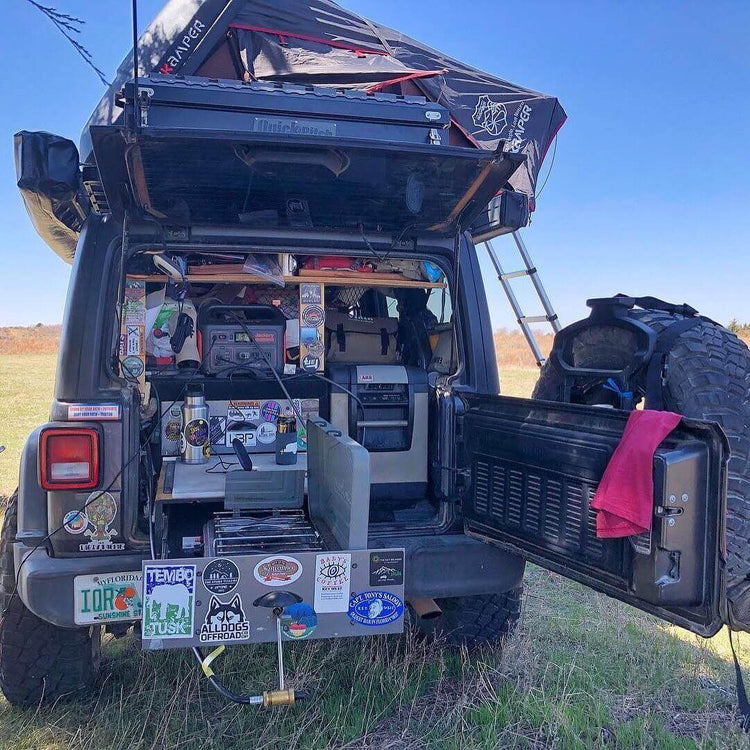Overlanding is more than a quick weekend trip into nature — nope. It’s about self-reliance, meeting challenges, gazing at the sites, and having a blast. But what makes the difference between your first overlanding adventure being just another one-off event or it being the first step towards a life-long passion?
The right camping gear makes all the difference. And in today’s post, Artemis Overland discusses some of the best overlanding gear for beginners and gives you some hot tips for getting started.
Things to Know Before Overlanding: Have a Plan!
Planning — it’s important. Before you go, know how you want to communicate, what kind of weather you’ll be expecting, who’s going with you, what’s your backup plan and if you have an exact route.
Proper planning, along with the proper gear, is just as critical for the veterans as it is for the beginner.
Essential Camping Gear 101: An Overlanding Vehicle
It probably goes without saying that if you’re overlanding, you’ll need a reliable, high-performance vehicle that likely has after-market modifications to help it endure steep, rocky terrain.
Vehicle add-ons or accessories can include:
- Skid plate (to stop rocks or pebbles from damaging the undercarriage)
- Off-road shock suspension (to handle driving up steep, hilly terrain)
- Higher torque, as opposed to speed (add a turbo or supercharger)
- All-terrain tires (you’ll need good grip and weather resistance)
- Tow Strap (precautionary, in case you need to pull your vehicle out of mud)
- Jack (preferably an off-road jack, but a normal one will do the trick)
- Spares (grab a spare of anything, really: tire, oil, fuel, fuses, or otherwise)
With the right planning and the right vehicle taken care of, let’s get into your personal camping gear.
The Best Overlanding Gear for Beginners
Water Container
No brainer - huh? Without water, we die. The RotoPax water carrier is a popular brand choice. It’s important that you pack enough water for showers and drinking. Take around ¾-gallons of water, at minimum, per person, per day.

Emergency Messenger
You’ll need a reliable way to contact help should you get lost, or should anything else occur. Emergency messaging devices don’t rely on cellular towers or signals to get reception.

Food Storage
Large coolers and food containers help keep your food fresh and eatable for days. Choose the right storage size and model for you, based on the number of people coming with you.
Tent [ Rooftop or Ground ]
Get a tent. The options are numerous: ground tents, awnings, or rooftop tents, be they soft-top or hard-top — doesn’t matter. It’s up to you. We offer plenty of choices, depending on your preference.

First-Aid
Remember that you’re far from a hospital. Having a first-aid pack with a full trauma kit on hand can be a literal lifesaver.

Fuel Tank
If your vehicle runs out of fuel in the middle of the wilderness, well…you’re toast. So bring a spare fuel tank, a Jerry Can, as a backup. You can thank us later.
Toiletries: Camping Toilet
Nature calls. So don’t forget to pack a portable toilet, or even a portable shower kit, if need be. The little things can make all the difference between a fun, memorable first-time overlanding experience and a slog.

Camping Stove
You’ll probably want some hot meals during your outing. Unless that is, you just plan on eating trail mix and protein bars out of a plastic bag; packing a camping stove is a bare-bones essential piece of gear.

Vehicle Repair Parts
The difference between overlanding and just camping or backpacking comes down to one thing: your vehicle. Make sure you can patch up a flat tire. Should it occur, you’ll need the right vehicle repair kit with you to do so, which could include a pouch set, ratchet set, or a scan tool.

Flashlight
You’ll need to see at night. Whether it’s just to find a piece of equipment, perform auto repairs, or to dig out that Snicker’s bar from your camping bag, a flashlight or tint light is an obvious must-have item.

Navigation Equipment
Traveling out into nature and then back into civilization might come down to having a good digital navigator. This is a must-have for any and all overlanding enthusiasts, but certainly for newbies. It’s also helpful to always keep a printed map in your vehicle as a backup.

Sleeping Mats
This one is the piece de resistance. The sleeping bag. Get some sleeping gear that’s weather-resistant, water-absorbant, comfortable, and easy to handle. There are plenty of great brands to choose from too. Take a look at our options.

Don’t Skimp on Packing Overlanding Equipment
There you have it. This is our list of overlanding gear for beginners. But just remember one thing. Even if it’s a non-essential camping item, like a hammock or a foldable camping chair, if you have the room for it, go ahead and throw that sucker in.
It’s those small creature comforts that can make your first overlanding adventure a comfortable, memorable, and enjoyable one. Besides, if you want to up the challenge, you can always choose to be a bit more spartan when packing for your future trips.

